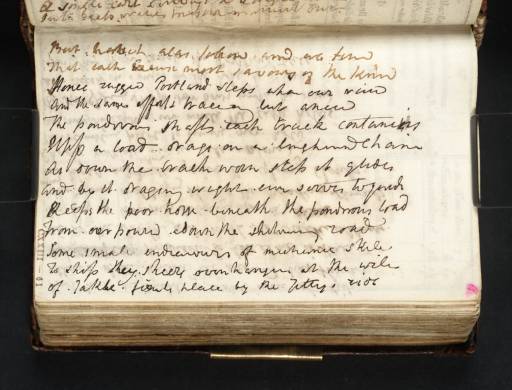Joseph Mallord William Turner Inscription by Turner: Draft of Poetry 1811
Joseph Mallord William Turner,
Inscription by Turner: Draft of Poetry
1811
Joseph Mallord William Turner 1775–1851
Folio 64 Recto:
Inscription by Turner: Draft of Poetry 1811
D08484
Turner Bequest CXXIII 61
Turner Bequest CXXIII 61
Inscribed by Turner in ink (see main catalogue entry) on white wove writing paper, 75 x 117 mm
Inscribed by John Ruskin in red ink ‘61’ bottom right, descending vertically
Stamped in black ‘CXXIII – 61’ bottom left, descending vertically
Inscribed by John Ruskin in red ink ‘61’ bottom right, descending vertically
Stamped in black ‘CXXIII – 61’ bottom left, descending vertically
Accepted by the nation as part of the Turner Bequest 1856
References
1862
Walter Thornbury, The Life of J.M.W. Turner, R.A. Founded on Letters and Papers Furnished by his Friends and Fellow-Academicians, London 1862, vol.II, pp.22–3.
1897
Walter Thornbury, The Life of J.M.W. Turner, R.A. Founded on Letters and Papers Furnished by his Friends and Fellow-Academicians: A New Edition, Revised with 8 Coloured Illustrations after Turner’s Originals and 2 Woodcuts, London 1897, p.211.
1909
A.J. Finberg, A Complete Inventory of the Drawings of the Turner Bequest, London 1909, vol.I, p.347, CXXIII 61, as ‘Verses’.
1990
Frank Milner, J.M.W. Turner: Paintings in Merseyside Collections: Walker Art Gallery; Sudley Art Gallery; Williamson Art Gallery; Lady Lever Art Gallery; Liverpool University Art Gallery, Liverpool 1990, p.38 under no.18.
1990
Andrew Wilton and Rosalind Mallord Turner, Painting and Poetry: Turner’s ‘Verse Book’ and his Work of 1804–1812, exhibition catalogue, Tate Gallery, London 1990, p.171.
The whole page is taken up with the following lines of verse:
But habit alas follow and we find
That each excuse most savours of the kind
Hence rugged Portland steps upon our view
And the same efforts tracing but anew
The ponderous shaft each track contane[‘s’ smudged and overwritten with ‘ins’]
Upsets a load drags on a lengthened chain
As down the tracks worn step it glides
And by it draging wight ever serves to guide
Keeps the poor horse beneath the ponderous load
From [?oer poured] adown the shelving road
Some small endeavours of mechanic skill
To ship they steer overhanging at the will
Of takle firmly place by the jettys [?‘side’ or ‘ride’]1
That each excuse most savours of the kind
Hence rugged Portland steps upon our view
And the same efforts tracing but anew
The ponderous shaft each track contane[‘s’ smudged and overwritten with ‘ins’]
Upsets a load drags on a lengthened chain
As down the tracks worn step it glides
And by it draging wight ever serves to guide
Keeps the poor horse beneath the ponderous load
From [?oer poured] adown the shelving road
Some small endeavours of mechanic skill
To ship they steer overhanging at the will
Of takle firmly place by the jettys [?‘side’ or ‘ride’]1
Interspersed with drawings and the printed pages of Coltman’s British Itinerary, sixty-nine pages of this sketchbook are given over wholly or partly to these verses which Turner intended as a commentary for publication with the Picturesque Views on the Southern Coast of England which he sketched on the 1811 West Country tour (see the introduction to the sketchbook). The first lines are on folio 18 verso (D08396), and the last on folio 207 verso (D08736; CXXIII 204a).
The previous passage, on folio 63 verso opposite (D08483; CXXIII 60a), refers to quarrying near Swanage, further east in Dorset. Here he continues his observations on the industry, on Portland, famous for the limestone used in many major buildings Turner would have known in London, including St Paul’s Cathedral. He made two sketches including the quarry below Portland’s Bow and Arrow or Rufus Castle in the Corfe to Dartmouth sketchbook (Tate D08837, D08838; Turner Bequest CXXIV 26, 27). Frank Milner suggests ‘Turner’s verse vision of Portland is far more active than the finished picture’,2 the watercolour Bow and Arrow Castle, Isle of Portland of about 1815 (University of Liverpool),3 engraved in 1817 for the Southern Coast.
Following Thornbury, Wilton and Turner read the last word of line eleven as ‘still’; Thornbury gives the beginning of the previous line as ‘From overpowered’.
The next lines, on the verso of the present leaf (D08485; CXXIII 61a), describe the dangerous Portland coast.
Matthew Imms
June 2011
How to cite
Matthew Imms, ‘Inscription by Turner: Draft of Poetry 1811 by Joseph Mallord William Turner’, catalogue entry, June 2011, in David Blayney Brown (ed.), J.M.W. Turner: Sketchbooks, Drawings and Watercolours, Tate Research Publication, December 2012, https://www

